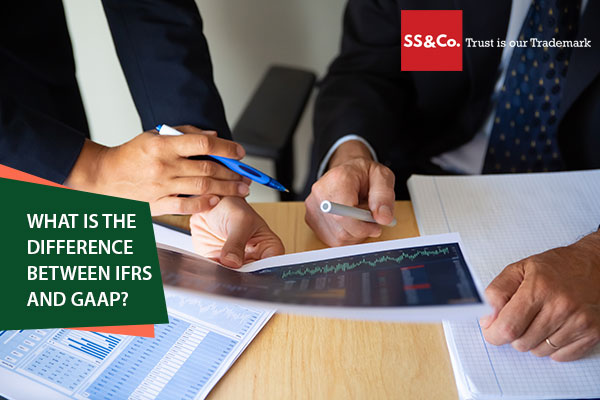What is the difference between IFRS and GAAP?

In the world of finance, the two major players that rule out the accounting principles are GAAP and IFRS. Both come with the same vision but different principles that aid businesses in making their financial statement clearer, more reliable, and honest. This transparency helps investors, regulators, and stakeholders to have a better understanding of a company’s financial data. That being said, just like two systems that are built on different parts of the world, GAAP and IFRS come with their own differences and interpretations. GAAP was introduced by the U.S. Financial Accounting Standards Board (FASB), which is familiar for its comprehensive, rule-based system with little flexibility, while IFRS was designed by the International Accounting Standards Board (IASB) with a principle-based mechanism that allows wider interpretation, giving more room for adaptability.
Businesses that operate on an international level must understand the dissimilarities between them for better scalability possibilities in global markets. It is necessary for precise reporting, better compliance, and gaining confidence in investors. Let us further closely recognize the differences between GAAP and IFRS and what Saudi businesses need to know when preparing or analyzing financial reports.
Understanding Accounting Standards
Accounting Standards are the defined rules and guidelines that govern how financial transactions are entered, reported, and submitted. This is important to make sure that all the financial data and statements are in a standardized format reflecting their true worth and an overview of a company’s financial performance and position. This facilitates the investors, regulators, and management teams to make thoughtful decisions regarding future budgeting, cash flow, and latest integrations. Without arranged guidelines, comparing businesses across industries or countries is out of the question.
The two accounting standards that are widely recognized are IFRS and GAAP. Although IFRS was developed by IASB and GAAP was established by FASB with distinct regulations, to bridge these differences, both boards have been working for years; still, there are some distinctions that stand out. Common variations lie in the methods through which both oversee the inventory costing, lease accounting, and research and development expenses.
What are Generally Accepted Accounting Principles (GAAP)?
The U.S. established the GAAP to develop financial principles that are applied across the country after the great depression of the 1930s. They appointed the Securities and Exchange Commission (SEC) to look after the creation of GAAP and guard the rights of investors while maintaining the stability of the market. Over the years, GAAP has transformed with new updates in accordance with the complexity of the American business environment. GAAP prioritizes compliance with strict rules for different industries, including the technology, healthcare, and finance sectors. It is therefore based on rules with rigid methods to deal with various situations, which makes it a more complex system.
What are International Financial Reporting Standards (IFRS)?
IFRS was developed to bring all the accounting standards under one umbrella by creating a unified accounting language. They were first presented as International Accounting Standards (IAS) in 1973, but later redesigned into IFRS with the latest changes and restructuring by IASB in 2001. IFRS is implemented by more than 140 countries today, which includes Saudi Arabia as well. The IFRS standards focus on professional judgement and the economic substance of transactions, unlike the strict compliance protocols of GAAP. IFRS is therefore more principle-based, giving broader guidelines and allowing flexibility for professionals.
The IFRS Adoption in Saudi Arabia
With the Rapid revolution and alignment with global practices, KSA officially implemented IFRS standards for listed and financial entities from January 1st, 2017, under the authority of SOCPA and CMA. This shift came with a purpose to,
- Foster visibility and boost investors’ confidence
- Ease the process of foreign investment by keeping it in line with global practices
- Back the goals of Vision 2030, which aims to merge the Kingdom’s economy with international markets
To facilitate the small and medium enterprises, SOCPA customized IFRS rules for them to encourage them by simplifying the reporting standards. This helped the local businesses adopt these principles more proficiently.
Core Differences Between IFRS and GAAP

1. Revenue Recognition
IFRS and GAAP have both merged through IFRS 15 and ASC 606, which is built on a five-step model to recognize revenue. IFRS is still less complicated as it prioritizes the transfer of control of goods or services to customers, while GAAP focuses on industry-specific guidelines. In KSA, industries like construction and telecommunications are obliged to apply IFRS to carefully analyze performance evaluation and the timing of revenue recognition.
2. Inventory Valuation
The IFRS is based on the First in and first out (FIFO) and weighted average cost methods, while GAAP allows the Last in and first out (LIFO) method as well. Since IFRS doesn’t allow LIFO, the companies based in KSA often report higher inventory value and profits in the inflationary periods as compared to the GAAP.
3. Research and Development Costs
IFRS permits the capitalization of development costs when the feasibility criteria are achieved, and GAAP demands both research and development costs to be expensed promptly.
4. Property, Plant, and Equipment (PPE)
The IFRS admits the revaluation of PPE to its current market price. For GAAP, on the other hand, the PEE is carried out at the original cost, subtracting the accumulated depreciation. In KSA, for bigger-scale investments in infrastructure and industrial projects, the IFRS revaluation model lets the companies present a clearer and realistic reflection of their asset worth.
5. Leases
For IFRS under IFRS 16, all the leases are viewed as financial leases, identifying a right-to-use asset and associated lease debt. GAAP under the ASC 842 divides it into two categories, operating and financial leases.
6. Financial Instruments
IFRS 9 works on principle-based classification, which uses business models and cash flow characteristics. While GAAP implements Stricker classifications like trading, held to maturity, or available for sale. This makes IFRS more adjustable to financial instruments, which are mostly used by Saudi Banks and Investment entities.
7. Impairment of Assets
IFRS works on a one-step approach that relies on recoverable amounts, but GAAP follows a two-step process, which can slow down the recognition of impairment losses. This specifically helps the Saudi companies in the energy and real estate sectors, as they can benefit from the IFRS straightforward strategy.
8. Intangible Assets
Under IFRS, the internally produced intangibles can be recognized if they meet the requirements. However, GAAP only recognizes them if they are generated externally. For businesses based in KSA that invest heavily in technological transformation, IFRS permits stronger recognition of these intellectual assets.
9. Presentation of Financial Statements
IFRS gives adjustability to businesses to organize their expenses according to their nature; GAAP, on the other hand, prescribes a specific format, which mainly requires a multi-step income statement. Saudi-listed companies on Tadawul can present their financial statements according to their local business model while keeping them aligned with IFRS compliance protocols.
10. Extraordinary Items
Any extraordinary items are not separately recognized under IFRS, but GAAP eliminates the separate classification. Saudi Companies, as per IFRS, can put forward their income and expenses as part of normal operations, which makes it easier for investors to analyze.
The Ongoing Journey Toward a Unified Global Accounting System
Throughout the years, many attempts have been made to bring the GAAP and IFRS principles closer. The main reason behind this was to set a single standard for all businesses on a global level. Regardless of these efforts, there are still some gaps, which is why full convergence is still in process.
Ongoing Efforts to Bring GAAP and IFRS Closer
The core steps that have been taken cover,
- The Financial Accounting Standards Board in the USA and the International Accounting Standards Board are working collaboratively to bridge the gaps by updating the standards
- Both have come up with similar protocols for revenue recognition under the ASC 606 and IFRS 15 to make the financial reporting more stable globally
Expected Future Directions in Accounting Convergence
In the coming times, there is a possibility of better progress towards the merging of IFRS and GAAP through
- Continued efforts between FASB and IASB on major areas
- Emphasize digital currencies, cryptocurrencies, and sustainability reporting
- Added regulatory policies that align with both standards
- Enhanced involvement of investors, accountants, and auditors to shape new standards
- Technological advancements of standards through clear guidance.
This convergence is critical to ease the financial reports across borders; it also cuts costs and complexity of understanding both, particularly multinational companies, and elevates the trust of investors and regulators.
Benefits of IFRS Adoption for Saudi Businesses
As we have discussed above that IFRS is the main standard used in KSA, and it brings many benefits with it for local businesses, such as:
- Global Recognition, which opens emerging doors of possibilities in global markets
- It gives investors’ confidence that the company is operating as per the international laws
- Supports the goal of Vision 2030 by encouraging competitiveness and cross-border partnerships
- Assist in mergers and listings for Saudi companies to expand internationally.
The multinational corporations in KSA that are based in the US are mandated to prepare dual reports with IFRS for Saudi subsidiaries and GAAP for their parent companies. This demands that businesses understand both standards and reconcile between the two frameworks, specifically in areas like asset valuation, revenue timing, and lease obligations.
Accounting and Advisory firms like SSCOKSA play a pivotal role in serving businesses in ensuring complete compliance with both systems. SS&CO, being the best chartered accountants in KSA, not just understands the local needs of IFRS but is also familiar with the U.S. GAAP to diminish any reporting inconsistencies.

